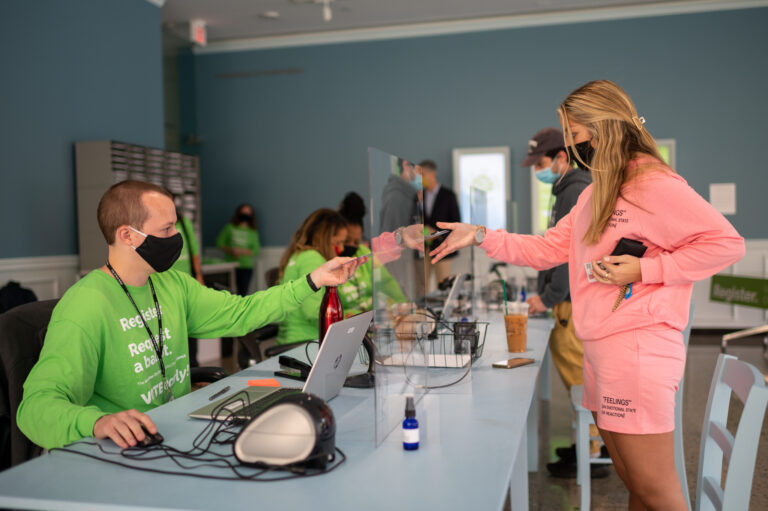
First-time voter Riley Friedman wasted no time casting his ballot in this year’s presidential election.
A junior at the University of Michigan School of Kinesiology, Friedman knew the process of casting a ballot could be daunting, so he decided to seek help on campus and voted in person at the newly opened Ann Arbor city clerk satellite office at the U-M Museum of Art.
“I’m from New York and I registered for the state of Michigan here at the clerk’s office,” he said. “I just showed up, registered in less than five minutes and voted right away. They helped me with everything, explaining what to do, filling out forms and telling me where to go. It was all just very easy and helpful.”

“There aren’t any stupid questions when it comes to voting,” she said. “We’re all working through this together and it’s expected that people have questions. The clerk’s office is in a convenient location and everyone there was enthusiastic about voting and patient with students working through the process. It’s very helpful.”
Friedman and Haughton—and many other U-M students—are beating the clock as time is ticking. The last day to register to vote in Michigan by mail or online was Oct. 19.
The UMMA satellite city clerk’s office has been registering between 150 and 200 students per day. As of Oct. 13, more than 2,600 students had registered and more than 2,900 have voted either in person at UMMA or by returning their ballot to the museum’s drop box.
Public policy student Meredith Days has not only voted already, but has been helping many others with the voting process as a volunteer at the clerk office. She has guided dozens of students registering for the first time and switching their registration to Michigan.

Image credit: Fernanda Pires
“Lots of out-of-state students move to Michigan and are able and eligible to vote here, but might not know how to do it, especially because they don’t have a Michigan driver’s license,” Days said. “Now, if they’re an out-of-state student, they can’t do online registration but can fill out a paper form here, register to vote and then get an absentee ballot in less than 10 minutes.”
Days is part of a team of 40 students working to support the satellite office. The group also volunteers at U-M’s Ginsberg Center, which is leading the Big Ten Voting Challenge, launched in 2017.
This competition is a nonpartisan initiative created to increase voter registration and turnout among students on all 14 Big Ten campuses. The average student voting rate across the conference was 43% in the 2018 midterm elections, just above the national average student voting rate of 40%.
The Ann Arbor campus saw its student voting rate triple, going from 14% in 2014 to 41% in 2018.
“We absolutely want and need our students to be bringing their perspectives to the ballot box into this election,” said Erin Byrnes, Democratic Engagement and Big Ten Voting Challenge leader at the Ginsberg Center.
“We’re all living in the context of COVID-19 and it can make people feel pretty powerless. But voting for those who are eligible is a way to exercise your power, make sure that your voices are heard. I think the power piece and knowing that you are doing something that will have a positive impact is really important.”

Increased turnout has also been spurred by other efforts like the Creative Campus Voting Project, created by U-M Stamps School of Art & Design professors Stephanie Rowden and Hannah Smotrich. Their research brought together various campus partners to launch the satellite office.
According to a report by the National Study of Learning, Voting, and Engagement, in presidential years, campuses of U-M’s size usually hover around the high 40s to low 50s in terms of percentage of voting rate.
“Despite the pandemic, we’re looking to nearly double that. Our goal is to have a 75% U-M student voting rate this year,” Byrnes said.
To reach this mark, Kari Rea, who recently graduated with a master’s degree from the Ford School of Public Policy, is managing Ginsberg’s marketing and social media content. The one-stop shop website for U-M student voting information, including FAQs and an Instagram page created a few weeks ago, are being constantly updated.
“It’s been really exciting to see students, staff members and faculty across campus being creative about how to spread the word about voting, how to do it, the importance of doing it,” Rea said. “And although so much of our work is happening from behind the screen now, it’s great to see people being engaged online and also in person in those socially distant, safe ways that we’re seeing at the city clerk’s office.”
Satellite office hours are:
- Oct. 24-Nov. 1: Weekdays 10 a.m.-7 p.m.; Saturdays 8 a.m.-4 p.m.
- Nov. 2: 8 a.m.-4 p.m.
- Nov. 3: 8 a.m.-8 p.m.


